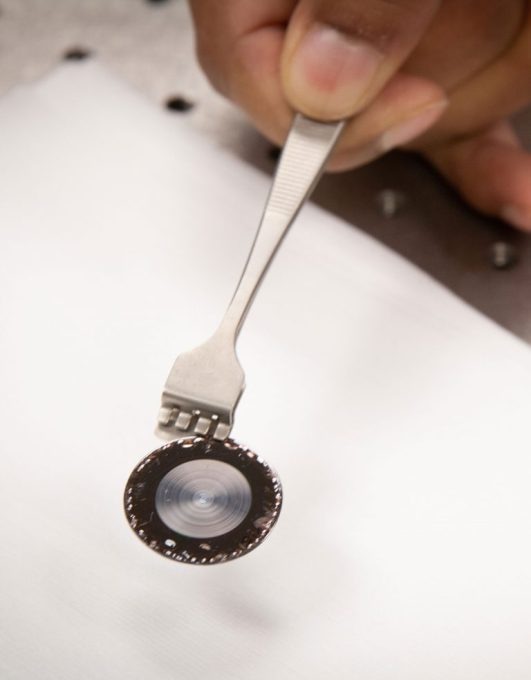Oct 10 2019
All new-generation smartphones that are introduced to the market come with unbelievable cameras that can generate excellent photographs. The only dissatisfaction is that the thick camera lenses on the back protrude out similar to awful bumps on a glass sheet.
 A flat lens developed by researchers at the University of Utah that is much thinner and lighter than a conventional lens that could produce lighter cameras for drones and night-vision cameras for soldiers. (Image credit: Dan Hixson/University of Utah College of Engineering)
A flat lens developed by researchers at the University of Utah that is much thinner and lighter than a conventional lens that could produce lighter cameras for drones and night-vision cameras for soldiers. (Image credit: Dan Hixson/University of Utah College of Engineering)
However, electrical and computer engineering scientists from the University of Utah have designed a new type of optical lens that is much thinner and lighter than traditional camera lenses that can be used for night imaging. This could be a future benefit for smartphones that could flatten those displeasing “camera bumps” and for drones and night vision cameras for soldiers.
The study outcomes have been reported in the latest edition of Proceedings of the National Academy of Sciences. The study is co-authored by electrical and computer engineering graduate students Monjurul Meem, Sourangsu Banerji, and Apratim Majumder; electrical and computer engineering associate professors Rajesh Menon and Berardi Sensale Rodriguez; and mathematics associate professor Fernando Guevara Vasquez, all from the University of Utah.
According to Menon, although traditional lenses for smartphone cameras are a few millimeters thick, their new lens is only a few micrometers thick, or a thousand times thinner than standard lenses.
Our lens is a hundred times lighter and a thousand times thinner, but the performance can be as good as conventional lenses.
Rajesh Menon, Associate Professor of Electrical and Computer Engineering, University of Utah
A typical curved lens captures light that bounces off an object and bends it before it eventually reaches the camera sensor that develops the digital picture. However, this new lens has various microstructures, each of which bends the light in the accurate direction at the sensor.
The researchers have developed a fabrication mechanism using a new kind of polymer in addition to algorithms that could facilitate the calculation of the geometry of such microstructures.
You can think of these microstructures as very small pixels of a lens. They’re not a lens by themselves but all working together to act as a lens.
Rajesh Menon, Associate Professor of Electrical and Computer Engineering, University of Utah
The finding is that the lens is flat rather than curved and is over 20 times thinner than a strand of human hair, with the additional potential of being applied to thermal imaging to observe objects in the dark.
Although this could finally generate smartphone cameras with no bump, it could also provide them the capacity to take thermal imaging to try locating heat signatures. However, a more imminent use for this technology would permit lighter military drones to fly longer for night missions or to map forest fires or identify victims of natural disasters. Moreover, soldiers in the field could carry considerably lighter night vision cameras for longer periods.
According to Menon, such a new lens could also be cost-effective to produce since the design enables these lenses to be developed from plastic rather than glass.
The study was supported by the National Science Foundation and the U.S. Office of Naval Research.